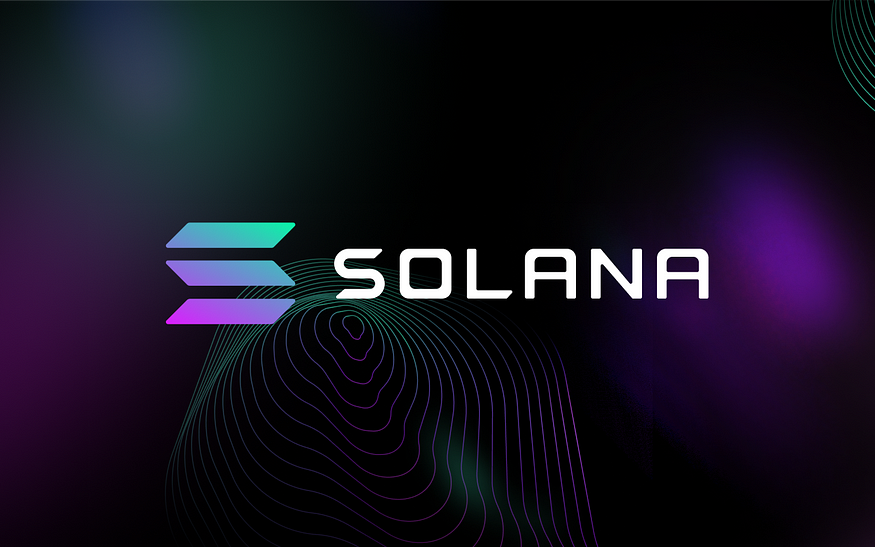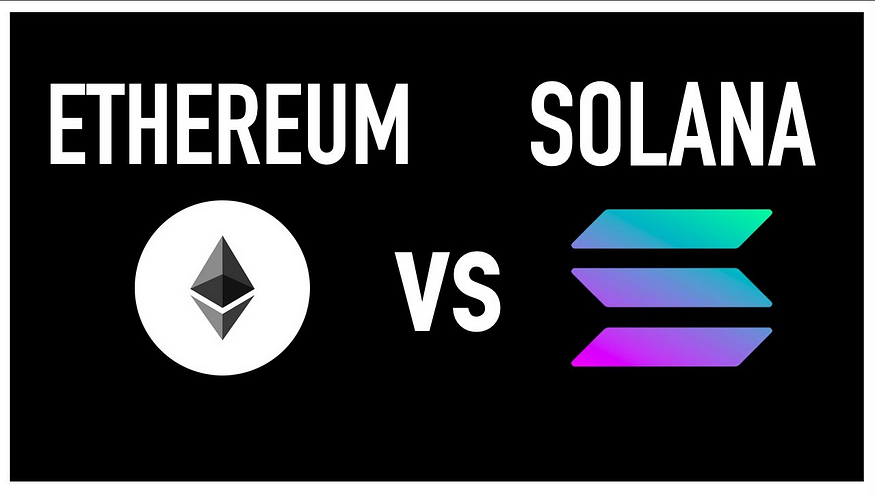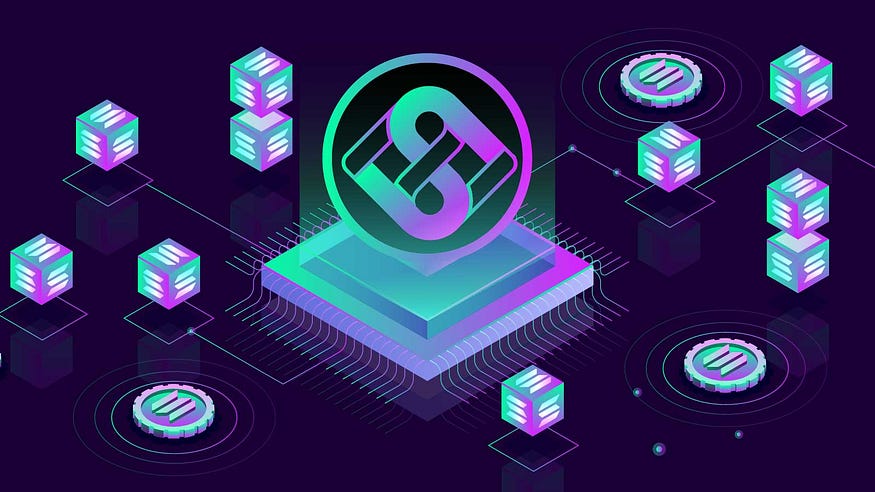Solana is a bit of a newcomer blockchain that has attracted a quite substantial developer community that builds on its crypto app ecosystem. Officially launched in 2020, Solana’s use of a timekeeping method called Proof-of-History in tandem with its Proof-of-Stake consensus protocol has made it fast, efficient, and very scalable.

What is Solana ?
Solana is an open-source blockchain platform that allows developers to create Dapps and smart contracts, with a focus on the decentralized finance (DeFi) realm. Built for speed, security, and efficiency, Solana has created a hybrid consensus mechanism incorporating proof-of-stake and a unique history protocol. The platform can handle up to 50,000 TPS (transactions per second), a staggering amount when compared to Visa which processes 1,700 TPS. It has also climbed 35 positions up the ladder of largest cryptocurrencies based on market cap, settling into the top 10 in just 18 months after launching. The network also creates new blocks every 400 milliseconds through a decentralized network of over 900 validating nodes and charges next to nothing for network fees. Since launching the platform has attracted big names across the DeFi, Web 3, crypto exchange, and online gaming industries who have all utilized the blockchain platform.
Solana also has its native cryptocurrency known as SOL. which works in a similar way to ETH on the Ethereum network. The cryptocurrency is used to pay gas fees, carries governance rights, and functions as a staking token as part of the PoS consensus that allows holders to validate transactions. Of the 500 million maximum supply, roughly 58% of the SOL are already in circulation.
How does Solana work?
well, Smart contracts are used to work and run the crypto applications on Solana. Solana a decentralized blockchain platform, which is substantially quicker than Ethereum, has grown to be a well-liked platform for developers due to its high throughput and minimal transaction fees. Its primary improvements, which are described below, enable it to overcome many of the drawbacks of other blockchain systems, including network capacity, expensive fees, limited throughput, and lengthy wait times for transaction confirmation. Its most famous feature, known as Proof-of-History, increases its value to developers by making it easier and faster to create and deploy decentralized applications (dApps) on its blockchain. One of the key features of Solana is its Proof of Stake (PoS) consensus system, which is backed up by Tower Consensus. This is a variant of the system known as Practical Byzantine Fault Tolerance (PBFT), it allows distributed networks to reach consensus despite attacks from malicious nodes. Solana’s PBFT implementation provides a global source of time on the blockchain through a Proof of History (PoH). Essentially, it provides a chronicle of previous events on the blockchain, ensuring that there is a general record of what happened and when.
3. Know the key Features of Solana?
- Solana can quickly add multiple properties to its existing network, whether its building applications or mining SOL tokens, this network can perform it all within microseconds. This cryptocurrency is often hailed as an “Ethereum competitor.
- Solana’s protocol is fast, secure, and censorship-resistant. The “decentralized” blockchain network that Solana offers, is a combination of proof of stake and proof of history. It is built on the RUST programming language which provides it with a robust.
- Solana follows a horizontal scaling method, which enables Solana to increase its scalability. Cloudbreak organizes a database that can read and write transaction input and also responsible for establishing a connection between hardware and software.
- Most of the tasks in Solana’s ecosystem are segregated to ensure the fast processing of transactions. Solana assigns the input data to different hardware that are involved in the network. Multiple hardware quickly validates the information blocks via a process known as pipelining.
4. Let’s know the advantages of using Solana:
- Proof of History
- Despite its name, PoH is not a consensus technique. Instead, it is a cryptographic clock that enables nodes to concur on the timing of the chain’s events without communication because each node has its clock. PoH boosts network efficiency and throughput by storing transaction history and making it straightforward for the system to keep track of the series of occurrences.
- BFT Tower (Byzantine Fault Tolerance)
- Solana’s version of pBFT (practical Byzantine fault tolerance), dubbed Tower BFT, is PoH-optimized. Essentially, it is a consensus technique that uses the cryptographic clock to obtain consensus without requiring nodes to exchange messages, which speeds up transactions.
- A Run-time for Parallel Smart Contracts
- Solana can grow horizontally across GPUs and SSDs because of this parallelized transaction processing engine. In essence, Sealevel improves network runtime by allowing parallel transactions on the same chain.
- Gulf Stream
- A Transaction Forwarding Mechanism without a Mempool. Solana is only able to reach 50,000 TPS thanks to the Gulf Stream. This protocol manages to cache transactions and send them to the network’s edge. It hugely reduces confirmation time and the memory demands on validators from unconfirmed transaction pools. It does so by enabling network validators to execute transactions beforehand.
- Block Propagation Protocol
- A block propagation technology called Turbine divides data into smaller chunks to facilitate data flow between nodes. Solana uses Turbine to improve the network’s overall transaction processing performance and handle bandwidth-related concerns.
Is Solana Network faster than Ethereum ?

Solana has received a lot of accolades for its speed and performance and has even been cited as a legitimate competitor of crypto industry leaders such as Ethereum. Solana is different from Ethereum In terms of processing speed, Solana is able to challenge the dominant smart contract platform, as it is supposedly capable of reaching a speed of over 50,000 TPS. Solana uses different consensus algorithms to avoid slow transaction confirmation. This feature makes Solana one of the fastest blockchains in the industry to compete with other industries outside of the crypto space. Compared to this enormous number, the current low scalable Ethereum proof-of-work model can only handle 15 TPS. Thus, Solana is thousands of times faster than Ethereum. Another Solana advantage is the network’s extreme cost-effectiveness, as the project implements new tokenomics for lower fees.
Solana’s Ecosystem
Solana offers a decentralized platform for DApps with global scaling potential, without the network congestion and high gas fees of the Ethereum network. The Solana community is a globally distributed home to developers, token holders, validators, and members supporting the protocol.
Solana’s scalability ensures transactions remain less than $0.01 for both developers and users. On Solana, you just have to Integrate once and never have to worry about scaling again. Solana ensures better composability between ecosystem projects by maintaining a single global state as the network scales. You Never have to deal with fragmented Layer 2 systems or sharded chains. Solana is all about speed, with 400 millisecond block times. And as hardware gets faster, so does the network. The topmost 5 dApps built on Solana Blockchain are listed below:
- Gameta a set to boost the mass adoption of the web 3 ecosystems. In other words, the platform’s interest is in ensuring interested persons have simplified and seamless access to Web 3.
- Magic Eden is a decentralized NFT buying and selling platform that allows users to buy, sell and trade unique digital assets. It is built on the Solana blockchain and allows users to interact with each other in a trustless environment.
- OpenSea The world’s first and largest digital marketplace for crypto collectibles and non-fungible tokens (NFTs). Buy, sell, and discover exclusive digital items.
- MEANfi is a user-friendly, self-custody, permissionless & trustless bank bringing crypto and DeFi to everyday banking workflows.
- Raydium- an Automated Market Maker (AMM) and liquidity provider built on the Solana blockchain for the Serum Decentralized Exchange (DEX)which has the first-mover advantage as an AMM within Serum and it will be an integral part of bringing new and existing projects and protocols into the ecosystem.
Solana’s community support for developers
Solan has a collection of core learning resources for developers onboarding on Solana including all types of DOCs, tutorials, developers series, and projects its own developer series , tutorials courses, developer tools and many more written docs to learn development on solana. Solana has an amazing ecosystem that empowers developers to build apps on their blockchain. Solana has a program that allows you to create your crypto token on its blockchain. ERC-20 Tokens are similar to Solana’s program.
Below are some useful developer resources.
The Solana Cookbook
this is a developer resource that provides the essential concepts and references for building applications on Solana. Each concept and reference will focus on specific aspects of Solana's development while providing additional details and usage examples.
SolDev
Solana content aggregator with easy discoverability for all your development needs including tutorials, tools, reference implementations and more.
Solana Docs
The core Solana documentation is used to provide a deep understanding of Solana concepts, architecture, programming models, and more.
Metaplex Docs
The core Metaplex documentation is used to provide understanding and implementations for building with NFTs on Solana.
About its grants,
Solana supports open-source projects that generate public goods for the community and give other ecosystem participants the opportunity to learn from and build on your work. anyone can apply for a grant from the Solana Foundation. That includes individuals, independent teams, governments, nonprofits, companies, universities, and academics. You can check out Alternative Funding Sources to know the list of initiatives they are currently looking to fund.
How to build on solana?

As mentioned previously, you aren’t required to know Rust or understand on-chain programs to build on Solana, although once you’re comfortable with building dApps you’ll likely want to learn how to create your own programs. On Solana, there are two completely different development workflows.
Program (smart contract) development on Solana is done in Rust, C and C++. These programs are built and deployed on-chain and are run via the Solana Runtime where they live forever. These programs can be used by anyone who knows how to communicate with them by submitting transactions with instructions to the network via the JSON RPC API or any SDK built on top of this API. Other on-chain programs can also make use of the JSON RPC API.
The foundation of app development on Solana is the JSON RPC API which is a layer of communication that allows you to interact with the blockchain. Solana Labs has created an easy-to-use Solana-web3.js SDK that allows you to talk to the blockchain and Solana programs in a way that feels just like talking to any other API you’ve used. There are many 3rd party SDKs that have also been built on top of the JSON RPC API such as Java, C#, Python, Go, Swift, Dart-Flutter, and Kotlin. You can access these SDKs on the Solana Developers Page.
Each of these SDKs gives you the power to build fully functional dApps on Solana in your favorite languages. Once you’ve mastered the Solana API you can then start to understand how to build your own programs in Rust, C, or C++.
In the world of decentralized applications, Solana is one of several competitors. As the network is supported by some of the best companies, like FTX, in an efficient manner. It offers a fantastic application ecosystem, which holds great promise. People who are interested in developing the blockchain and dApp ecosystem should at the very least give Solana a go. So keep following MiningDevs for more enlightening articles on different blockchains like this.





0